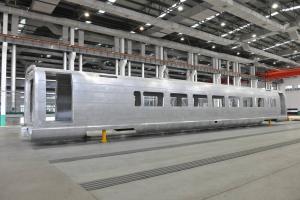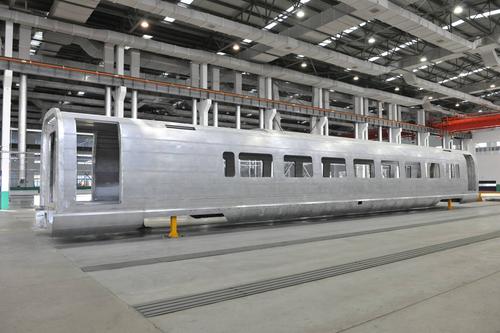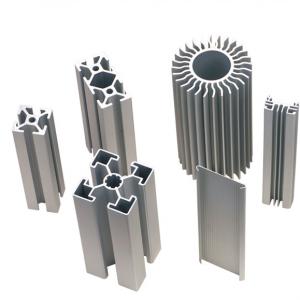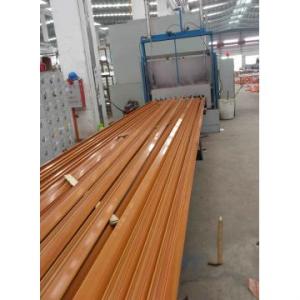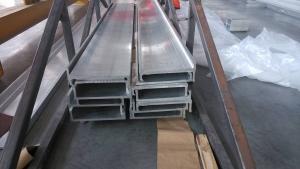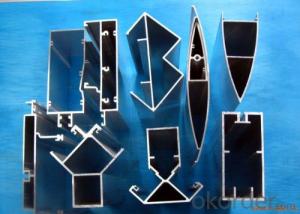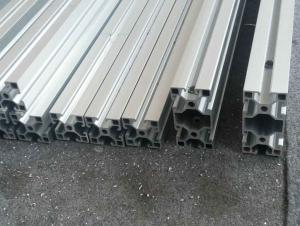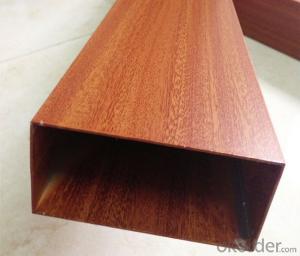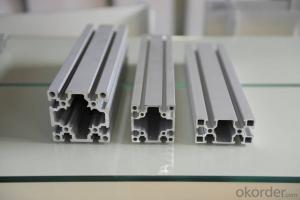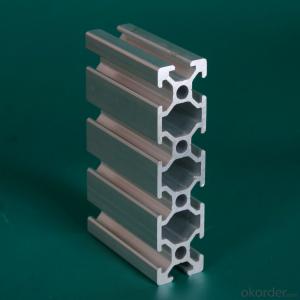Aluminum Extruded Profiles for Truck Bodies
- Loading Port:
- China Main Port
- Payment Terms:
- TT OR LC
- Min Order Qty:
- -
- Supply Capability:
- -
OKorder Service Pledge
OKorder Financial Service
You Might Also Like
Aluminium truck body made of extruded profiles
1. Usage:High-speed railway and Metro
2. Surface: Mill finish or anodized as customer’s requirement
3. Alloy: alloy temper 6005A, 6101, 6061,etc.
4. Standard: EN755
5. Lead time: shortest delivery time
6. OEM/ODM is available
7. Advantage:
Tolerance applied by international standard
Low energy consumption, low gas emission,
high speed, environmental friendliness
Product Name | Aluminum profile for subway body |
Size | As customers’ requirements |
Material | 6061 6005 7020 7005 7003 7A09 |
Temper | T5 T6 etc. |
Standard | GB /ASTM |
Surface Treatment | Anodized/powder coating |
Colour | Mill finish |
Application | Transportation,Jambo,Machine, Equipment |
Origin | China |
Port | Shanghai |
MOQ | 5 Tons |
Delivery Time | 90 work days after deposit or original L/C |
Payment Terms | T/T, L/C |
Supply Ability | 5000Tons / Month |
Packaging | Export standard packing |
- Q: How do you protect aluminum profiles from scratching or damage?
- There are multiple methods available for safeguarding aluminum profiles against scratches or damage. To begin with, a commonly used approach involves applying a protective coating or finish. This can be accomplished by utilizing paints, lacquers, or powder coatings that serve as a barrier between the aluminum surface and external elements. These coatings not only enhance the appearance but also offer protection against scratches, corrosion, and other forms of damage. Another effective temporary solution is the utilization of protective film or tape. These films or tapes can be directly applied onto the aluminum profiles, acting as a shield. Generally transparent, these films can be easily peeled off once the profiles are installed or ready for use. A different technique involves handling and transporting the aluminum profiles with caution. This entails the use of appropriate handling equipment, such as gloves, to avoid direct contact with the surface. Additionally, the use of protective packaging materials like bubble wrap or foam can provide cushioning during transportation, preventing scratches or dents. Regular cleaning and maintenance of the aluminum profiles is also crucial. Dust, dirt, and debris can act as abrasives, causing scratches over time. Cleaning with a soft cloth or sponge and mild detergent on a regular basis can help eliminate these particles and preserve the profile's appearance. Lastly, implementing proper storage practices is of utmost importance. Storing aluminum profiles in a dry and clean environment, away from sharp objects or heavy items, can minimize the risk of scratching or damage. The use of racks or shelves with protective padding can provide an additional layer of protection. By adhering to these measures, aluminum profiles can be effectively safeguarded against scratches or damage, ensuring their durability and preserving their aesthetic appeal.
- Q: Are there any limitations on the length of aluminum profiles?
- Yes, there are limitations on the length of aluminum profiles. The length of aluminum profiles is typically limited by factors such as the manufacturing process, transportation constraints, and practicality. In terms of manufacturing, aluminum profiles are usually extruded or rolled, and the length is limited by the equipment and capabilities of the manufacturer. Extrusion presses and rolling mills have certain size limitations, which determine the maximum length of aluminum profiles that can be produced. Transportation constraints also play a role in limiting the length of aluminum profiles. Longer profiles may be difficult to transport due to logistical challenges, such as the size of trucks or shipping containers. Moreover, the risk of damage or deformation during transportation increases with longer profiles. Practicality is another factor that imposes limitations on the length of aluminum profiles. Longer profiles may become less rigid and more prone to sagging or bending under their own weight, making them less suitable for certain applications. Additionally, longer profiles may be more difficult to handle and install, requiring specialized equipment and techniques. While there are limitations on the length of aluminum profiles, manufacturers can often produce profiles in various lengths to meet specific project requirements. However, it is important to consider these limitations and consult with the manufacturer to determine the feasibility of producing longer profiles if needed.
- Q: Can aluminum profiles be used in signage or display applications?
- Yes, aluminum profiles can be used in signage or display applications. Aluminum profiles are versatile and lightweight, making them ideal for creating durable and visually appealing signs and displays. They can be easily cut, shaped, and joined together to create custom frames, panels, and structures for various signage and display purposes. Aluminum profiles also offer excellent corrosion resistance, ensuring that the signs or displays remain intact and attractive even in outdoor or high-moisture environments. Additionally, aluminum profiles can be powder coated or anodized to provide a wide range of color options, allowing for branding or customization. Overall, aluminum profiles offer a reliable and cost-effective solution for signage or display applications, providing both functionality and aesthetics.
- Q: Are aluminum profiles suitable for the furniture industry?
- Yes, aluminum profiles are highly suitable for the furniture industry. Aluminum is a versatile and durable material that offers numerous benefits for furniture manufacturing. Firstly, aluminum profiles are lightweight, making them easy to handle and transport, especially for bulky furniture items. This feature not only reduces transportation costs but also makes the furniture more user-friendly during installation and rearrangement. Secondly, aluminum is highly resistant to corrosion, ensuring that furniture made with aluminum profiles will withstand harsh weather conditions and remain durable over time. This makes it suitable for both indoor and outdoor furniture applications. Another advantage of aluminum profiles is their design flexibility. Aluminum can be easily extruded into various shapes and sizes, allowing for endless design possibilities. This versatility facilitates the creation of customized furniture pieces to meet specific client requirements. Aluminum profiles also offer excellent strength-to-weight ratio, making furniture made with aluminum sturdy and long-lasting. This feature is particularly beneficial for items that undergo regular use, such as chairs and tables. Furthermore, aluminum is a sustainable material as it is 100% recyclable. This aligns with the growing demand for environmentally-friendly furniture options. Manufacturers can easily recycle aluminum profiles at the end of their lifecycle and use the recycled material to create new furniture items, reducing waste and contributing to a circular economy. Overall, the unique properties of aluminum profiles make them highly suitable for the furniture industry. Their lightweight nature, corrosion resistance, design flexibility, strength, and recyclability all contribute to creating high-quality and sustainable furniture products.
- Q: How do aluminum profiles perform in terms of thermal conductivity?
- Aluminum profiles exhibit excellent thermal conductivity, allowing them to efficiently transfer heat and manage temperature fluctuations.
- Q: Can aluminum profiles be used in elevator or escalator systems?
- Yes, aluminum profiles can be used in elevator or escalator systems. Aluminum profiles are lightweight, durable, and corrosion-resistant, making them suitable for various applications, including the construction of elevator and escalator components. Aluminum profiles can be used for the structural framework, handrails, cladding, and other parts of an elevator or escalator system. Additionally, aluminum profiles can be easily customized and fabricated to meet the specific requirements of each project. Their versatility, strength-to-weight ratio, and aesthetic appeal make aluminum profiles an excellent choice for elevator and escalator systems.
- Q: This question asks for a method to calculate the quantity of aluminum profiles required for a construction project.
- <p>To calculate the amount of aluminum profiles needed for your building project, first, measure the dimensions of the area where the profiles will be used. Determine the length and width of each profile required. Multiply these dimensions by the number of profiles needed for each section of the project. Add up the totals for all sections to get the overall quantity. Consider the type of profile and its application, as this will affect the quantity and specification. Factor in a small percentage for waste and cutting errors. For complex projects, consult with an engineer or use specialized software to ensure accuracy.</p>
- Q: What are the reasons for the large number of products in the aluminum profile cutting machine after opening?
- When sawing, lubrication is insufficient, check the lubrication system, and the other may be aluminum material is not good
- Q: Can aluminum profiles be used in agricultural machinery manufacturing?
- Yes, aluminum profiles can be used in agricultural machinery manufacturing. Aluminum is a lightweight and versatile material that offers various benefits for agricultural machinery. It is corrosion-resistant, which is essential for equipment exposed to harsh weather conditions and chemicals used in farming. Additionally, aluminum profiles provide excellent strength-to-weight ratio, allowing for the construction of sturdy and durable machinery without adding unnecessary weight. Aluminum's high thermal conductivity also enables efficient heat dissipation, preventing overheating of machinery components. Moreover, aluminum profiles can be easily formed, machined, and welded, providing flexibility in design and manufacturing processes. Overall, the use of aluminum profiles in agricultural machinery manufacturing can result in improved performance, fuel efficiency, and reduced maintenance costs.
- Q: This question asks for the typical specifications and measurements of aluminum profiles that are used in the construction of building frames.
- <p>Aluminum profiles used in building frames come in various specifications and measurements. Commonly, they include I-beams, T-profiles, and C-channels with different thicknesses and dimensions. Sizes can range from 30mm to 200mm in width and from 1mm to 10mm in thickness. The length of these profiles can vary, but they are often available in standard lengths such as 6 meters. Specific dimensions and tolerances are determined by the building's design requirements, load-bearing needs, and manufacturing standards. It's also important to consider the alloy type, which can affect strength and corrosion resistance. Always consult with an engineer or supplier for the exact specifications suitable for a particular project.</p>
Send your message to us
Aluminum Extruded Profiles for Truck Bodies
- Loading Port:
- China Main Port
- Payment Terms:
- TT OR LC
- Min Order Qty:
- -
- Supply Capability:
- -
OKorder Service Pledge
OKorder Financial Service
Similar products
Hot products
Hot Searches
Related keywords
